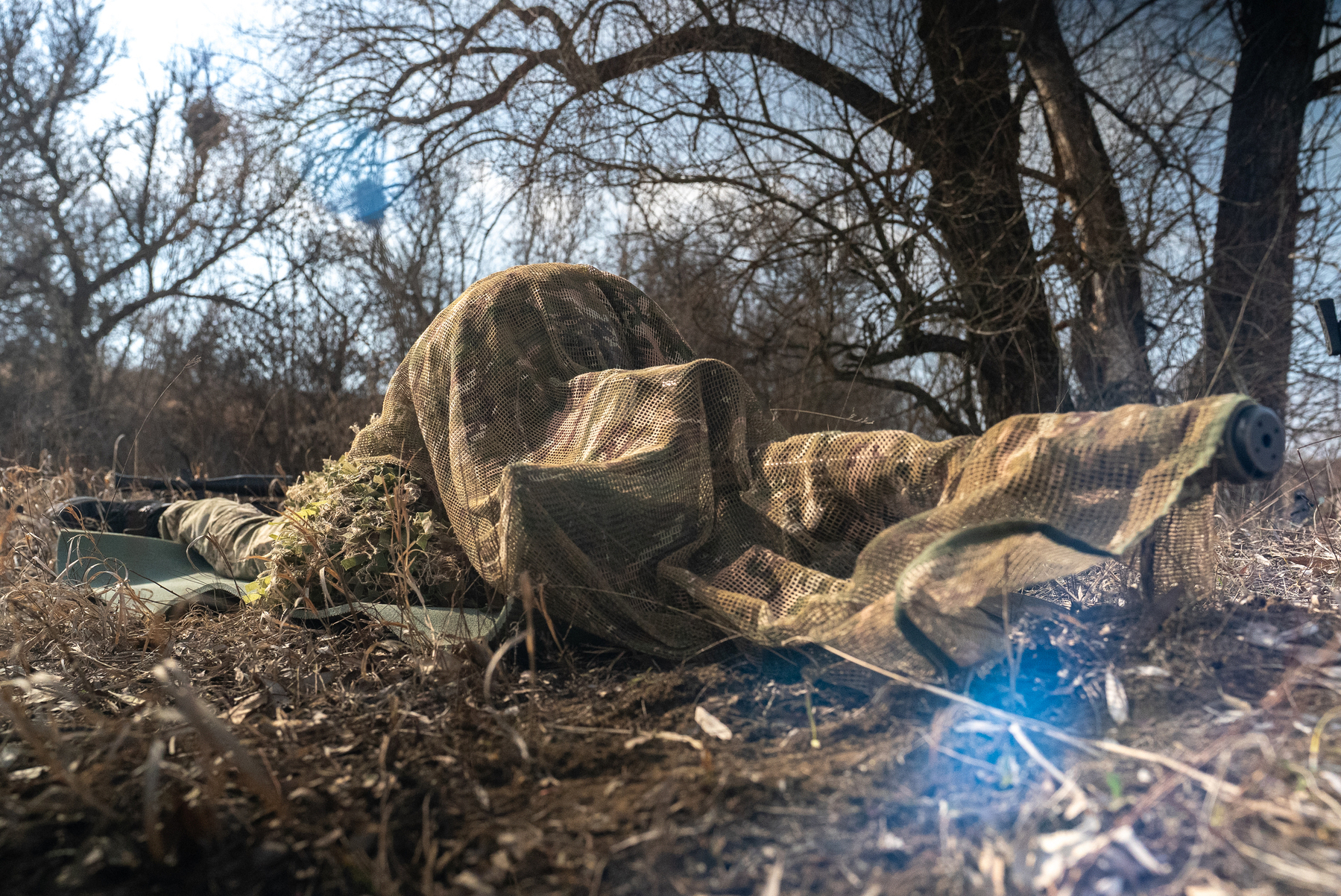
The men are loading many things into the car, including backpacks and bags with ghillie suits. They place massive sniper rifles there, too — with special care.
The car speeds down the dirt road, kicking up dust.
Training ground is large and varied in terrain, which allows soldiers to practice shooting from different positions and distances.
The snipers unload their equipment, sling the rifles over their shoulders, and head to the training area. Gwara Media follows — to learn about the specifics of how snipers work. A soldier with a call sign “Faust” will guide the journalists through the shooting training.
Soldiers come here whenever they have free time, he says.
“We also go to the frontline to carry out combat missions. Of course, we don't just stay in one place. When we are free, we set aside time for ourselves and go shoot from different distances to improve our skills.”
“Faust” was mobilized into the military in 2023 — but because he had people who were interested in sniper work, he and his team got sent to the “Marksman” course, which provided spiner training for infantry. He went through the entire course, really liked the training, and decided to join the profession.
“Everything depends on the tasks set”
The work is hard but interesting, says “Faust.” Snipers are not only shooters but also scouts.
“We do not necessarily arrive at the position and shoot. We can help our team or artillery more by observing and noticing something than by taking a single shot.”
“Faust” says one of the challenging, difficult moments in this process is the entry and exit from a position. It requires careful planning and choosing camouflage materials to blend in with nature.
The selection of weapons and equipment depends on the tasks set, says “Faust” — depends on the distance at which the enemy is located, the weather, terrain, and available foliage. All of it can affect a sniper’s work.
In urban areas snipers mostly work from inside the buildings or from their roofs. That limits their options for picking a position, shortens the shooting range up to 500 meters, and creates all sorts of difficulties.
On the open terrain, the effective range of snipers is much longer — up to one kilometer.
“Situations are always different. There are no templates. Sometimes, we come up to 200 meters (to the frontline — ed.). Sometimes, we come up to a kilometer. To do this, we plan through entry and exit (to the position), the sector in which we work, the presence of the enemy and their resources, and available communications with adjacent units. We analyze the situation and then start working.”
“Sometimes we walk to the position for seven kilometers”
“The most comfortable shooting position is lying down,” says “Faust,” unrolling the mat.
Lying down keeps a sniper’s body stable, “Faust” explains, so it’s easier to take a shot. During combat missions, they can't afford this level of comfort often — snipers work in forests, over hills and ravines, in cities and villages. The weather also varies, and it impacts the work as well.
“Faust” changes his position — he gets down on one knee and raises his rifle.
This position is more difficult, he explains. “You don't have much time to shoot because then the tremor starts. You have to make quick decisions.”
“Tripods (weapon tripods — ed.) are a good thing, quite often very useful. But you have to carry them on yourself. Sometimes, we have to walk for seven kilometers or more to reach the position.”
“Accuracy and precision”
The snipers are equipped with the Ukrainian-made UAR-10 rifle by the company “Zbroiar.”
“It is already in service. It has proven itself quite well. It is compact and easy to use,” says “Faust.”
In 2018, UAR-10 was officially adopted by the Armed Forces of Ukraine. The rifle weighs 5.5 kilograms and can shoot at a distance of up to 1200 meters.
“We also have other weapons: Savage and Ruger are America-made. They are of the 338th caliber, so they have a much longer range — up to 2,000 meters.”
Optical sights are important for longer-range shooting. After being mounted on the rifle, the sights need to be calibrated. The calibration is done at a distance of 100 meters, and the number of shots during calibration depends on how much the optics need to be adjusted. It can be three, five, or even ten shots to bring the sight and the weapon to the required level of precision, says “Faust.”
“Faust” doesn’t know if Russians have their own domestically-made rifles, but he heard they have Western models in the arsenal.
“I haven't encountered Russian snipers yet here (in Kharkiv Oblast). But they performed quite well in Toretsk. As sad as it may sound, there were cases where they were effective. Their training is also professional, and they have very good specialists and, I believe, decent weaponry.”
Author: Polina Kulish
English translation: Elza Diachenko
Hi! Thanks for checking out our report from sniper training — it's important for us to stay in touch with the soldiers of the Armed Forces and tell you about their lives and work. Please, consider buying our journalists a coffee or subscribing to our Patreon to support our Kharkiv-based newsroom reporting long-term.
Read more
- Poll: 97% of people in Ukraine trust soldiers on frontline, 90% have friends in army
The post “Blending in with nature” — Sniper training in Kharkiv region (photos) appeared first on Gwara Media.
